Product Review - Sony SCD-CE775
CD/SACD Player - Part 2 - April, 2002
John E. Johnson, Jr.
![]()
I tested the 775 with our BAT VK-5i preamp (two-channel mode), Yamaha DSP-A1 (5.1-channel mode), BAT VK-75SE, McIntosh MC-602, Cinepro 3k6SE Gold, Theta Casablanca II (two-channel mode), Carver MK-IV speakers, Krix Esoterix I Mark II speakers, and Threshold ES-500 ESL speakers. Cables were Nordost and BetterCables.
Let's get right to the point. Does SACD sound noticeably better than CD? Yes, it does, and because I am in my fifties, my hearing is not as good as it used to be, but it was still obvious. I have grown to love digital music over the years, but I did not realize how much improvement was left for the future. All of a sudden, what used to sound so good, now sounded like a blanket had been thrown over it. SACD has much more body and detail to it. And that is even using just two-channel SACD. It is impossible to really compare 5.1-channel SACD to two-channel CD, so I did a lot of listening to SACDs in two-channel mode (this comes from the two-track SACD version of the music that is on the disc along with the 5.1 tracks, so the down-conversion is done in production at the studio rather than in the player). Sony does not produce hybrid SACDs, so I used the various Telarc SACD releases which are hybrid. Remember, the CD layer on hybrid discs are simply the DSD recordings that are converted to CD PCM, so it is not a true comparison. However, even my regular CDs sounded thin by comparison.
The sound staging was also much more precise with SACD, I suppose because there is a lot more information there. We have heard that SACD has a problem with accuracy above 8 kHz, so I listened to some SACD jazz, particularly to the cymbals in the drum section. They did sound a bit more splashy than CD, but it did not sound bad, just somewhat different, and I could not tell if it was due to an improvement because of the DSD encoding strategy, or the problem that is supposed to be there. The disc I used for this specific test was Michel Camilo's "Triangulo", which is a recent Telarc release.
Let's assume there is a measurable difficulty in the > 8 kHz area. I still liked the resulting sound more than CDs, and we can expect that Sony/Philips will improve it as time goes on.
In 5.1 mode, SACD is certainly a huge improvement over DD and DTS, but that is a given since SACD has much more musical information on it than these movie sound formats, let alone conventional CD. I hope that HD-DVD will let us have these high resolution sound formats to go with the movies. Apparently, DTS has the capability of 5.1 channel, 24 bit - 96 kHz sampling in its specification.
In the menu settings of the 775, Sony has something they call "Multi-Channel Management". This is the bass management system that SACD players have to make up for the fact that they only output the 5.1 analog to your receiver, which bypasses bass management in the receiver. To access it in the 775, you press the Menu button, then turn the AMS dial until it says "Mch Spk Mode", then press the dial, at which point you will see various choices of bass management in the LED panel. The choices are shown in the chart below.
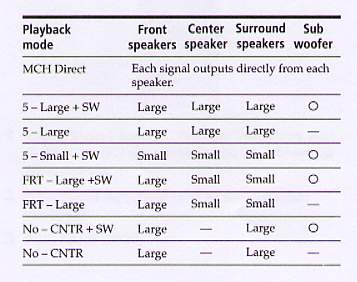
You can also adjust the volume balance between the front channels and the center channel, between the front speakers and the surround speakers, and between the front speakers and the subwoofer. Sony says not all functions will work at the same time, depending on what you choose in bass management. Alas, unlike with the much more extensive management that you get with any modern receiver, there is no time alignment in the 775 management. So, for example, you can't put a few milliseconds delay in the rear surround speakers.
On The Bench
The frequency response of the 775 is pretty typical of a CD player, as shown below. I measured the 20 Hz - 100 Hz range and 100 Hz - 20 kHz range separately. It is smooth out to about 2 kHz when it begins to slowly drop, but stays within 0.5 dB out to 20 kHz.
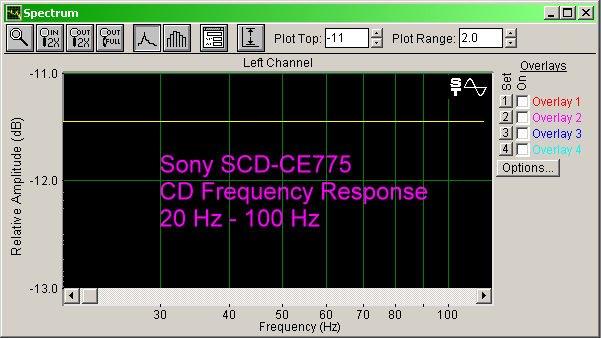
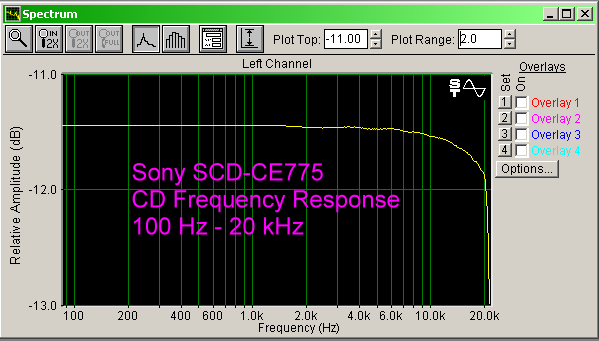
THD+Noise performance is very good, as shown below. Using a 1 kHz sine wave input, I measured only 0.00243% distortion plus noise, with harmonics at 2 kHz and 3 kHz. The noise floor is excellent, at - 125 dB.
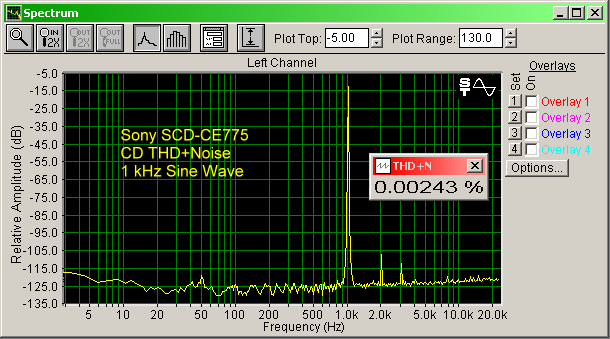
Intermodulation Distortion (IMD) performance is also quite good, as shown below. I used two input sine waves, one at 11 kHz and one at 12 kHz (the two large peaks). In the full range plot, there were peaks at 1 kHz, 10 kHz, and 13 kHz, along with some above 20 kHz (top plot). A close-up (bottom plot) shows the main peaks at 11 kHz and 12 kHz, along with the IMD peaks at 13 kHz and 10 kHz, but that is all that is there. IMD is the most important type of distortion. It occurs as a result of two frequencies, A and B, interacting to produce other peaks at A-B and A+B. You also then get further IM peaks when the first set of IM peaks interact with each other and the original signal frequencies. So, in the IMD plot below, with the original frequencies at 11 kHz and 12 kHz, you get IM peaks at 12 - 11 = 1 kHz, and 11 + 12 = 23 kHz.
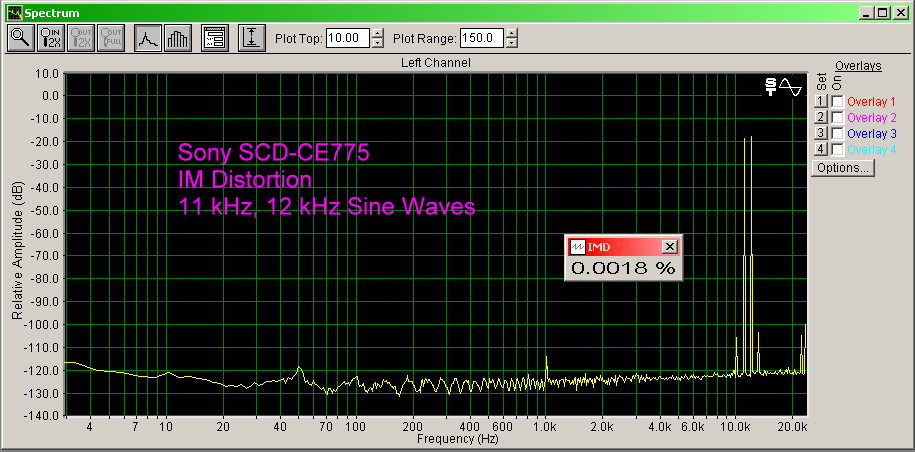
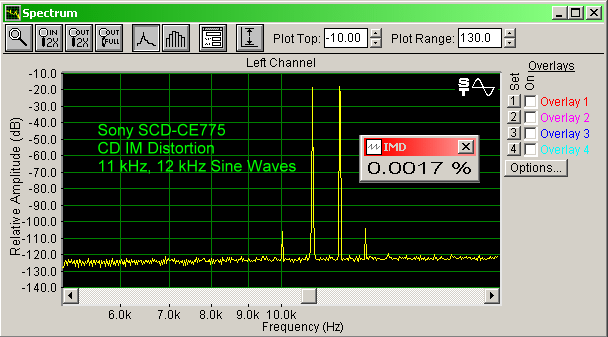
If you compare the IMD of the 775 with one of my older CD players, the Sony CA-80ES (purchased 2 years ago, at a higher price than the 775), shown below, you will see how good the 775 is. The two input peaks are pointed out by the red arrow, and all the IMD harmonics are pointed out by the green arrows. So, this large array of harmonics was produced by having just two input tones. You can imagine the mess that can occur when you have numerous input frequencies at the same time, such as would be the case with a symphony orchestra. Such IMD would make the sound mushy, particularly in the midrange where harmonics are close together. And, the CA80ES did sound mushy to me when lots of instruments were playing. Notice also that the noise floor of the 80ES is a few dB higher than that of the 775. I think the 775 superior CD performance is due to having much better DACs, and the necessary improved electronic design that is required for SACD. I don't have SACD test tone discs at this point so cannot test IMD or THD+Noise with SACD test tones.
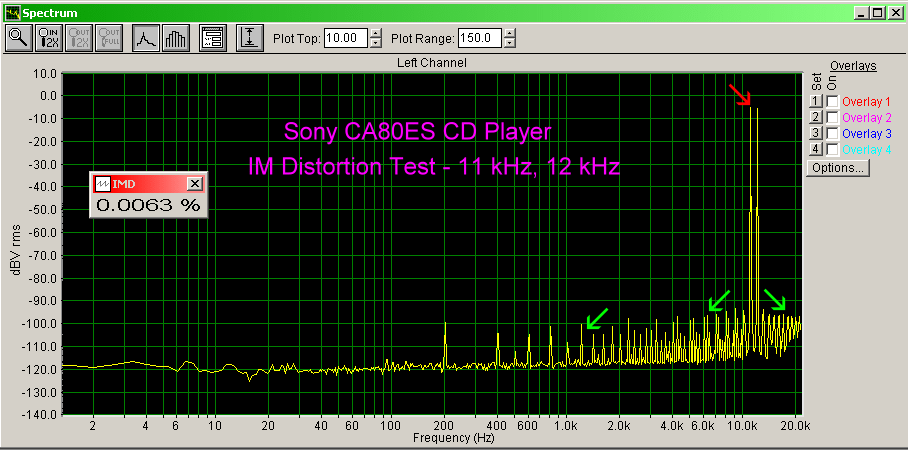
Note that the 80ES has higher IMD, but a slightly better frequency response near 20 kHz, within 0.25 dB (plots shown below).
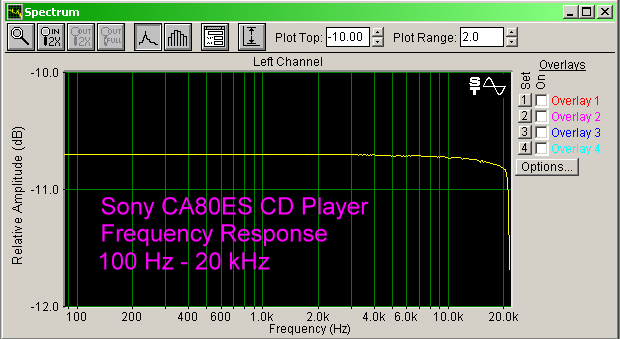
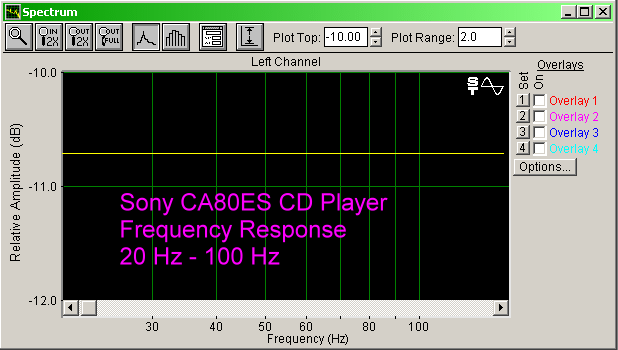
Conclusion
If you are getting ready to purchase a mass market CD player, consider one that has SACD capability, like the Sony SCD-CE775. They are about the same price as a mass market CD player, and you will likely get better CD performance along with the added capability of being able to play the new - and marvelous - SACDs that are hitting the music store shelves. At $179 street, the 775 is a winner.
- John E. Johnson, Jr. -
![]()
© Copyright 2002 Secrets of Home Theater & High Fidelity
Return to Table of Contents for this Issue.

